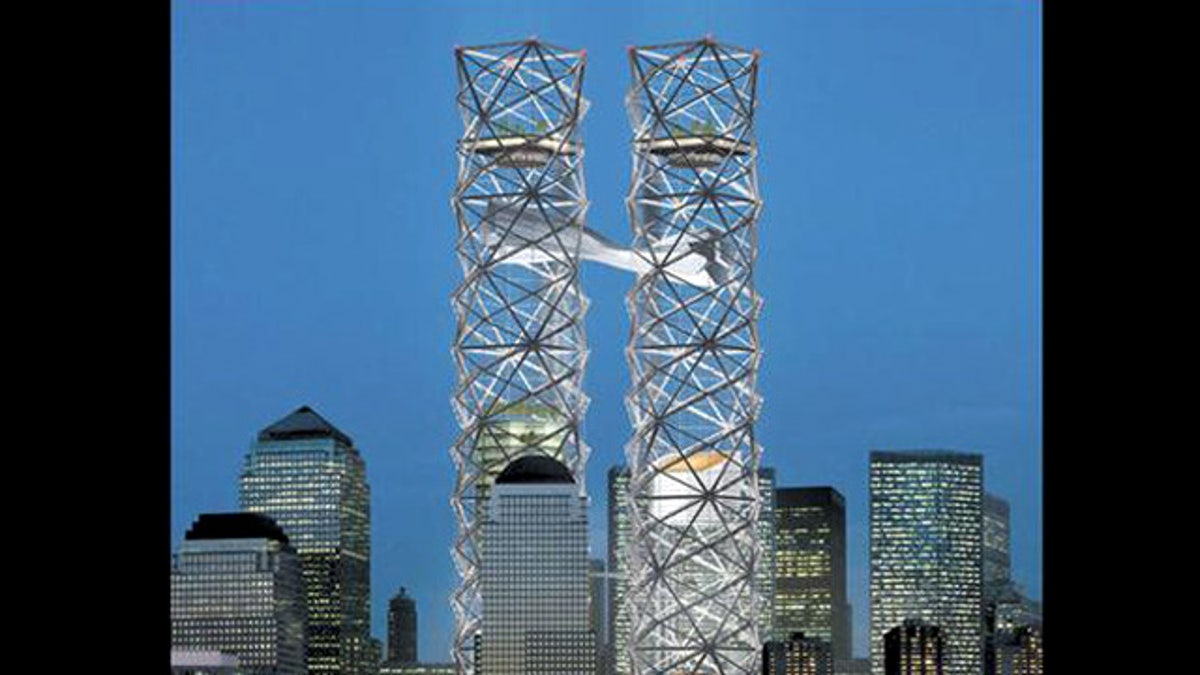
The World Cultural Center, a finalist among proposed design plans for the World Trade Center site, featured a skybridge -- one of several modern concessions to safety following 9/11.. (AP)
The 9/11 attacks threw the architectural world into shock. “The age of skyscrapers is at an end,” city planner Howard Kunstler declared just after the tragedy, and Donald Trump reduced the height of a planned tower in Chicago, citing security concerns raised by 9/11.
But since the tragedy, architects have used advances in construction materials and new designs to make tall buildings safer -- and more likely to withstand a 9/11-style attack.
“Certain things that were virtually unheard of 15 years ago are now pretty routine,” Architectural expert Martin Moeller, senior vice president of the National Building Museum, told FoxNews.com.
“Take the typical concrete sidewalk. It might be able to resist a couple thousand pounds per square inch. There are now concretes that resist 25 thousand pounds per square inch,” he said.
Very high-strength cement can help a building resist the type of impacts caused on 9/11 by protecting the steel that holds skyscrapers together -- the weak point in the attacked towers.
“It was the heat of the fire which severely weakened, ultimately beyond repair, many of the steel elements that not only held the floors up but kind of held the building together,” Moeller told FoxNews.com.
The steel beams of the old World Trade Centers were insulated from fire with fire-retardant chemicals that make it look like it was covered in foam. But that didn’t work very well.
“That may be fine for a warehouse,” Moeller said. “But on 9/11, when those planes flew into the buildings, the foam was just blown off. Now, there are other ways to protect the steel.”
For instance, in 7 World Trade Center -- the first of the destroyed buildings to be rebuilt, in 2006 -- three feet of concrete now surround the steel core.
Steel has also been getting stronger, as scientists have gradually found better alloys. A new discovery this year by an entrepreneur in Detroit found that rapidly heating and then cooling steel in the factory made it 7 percent stronger. Gary Cola, the inventor, has named his new steel “Flash Bainite.”
“No guarantees -- but my contention is that a temperature-resistant steel like Flash might have let the World Trade Centers stand a little longer to get a few more people out of harm's way,” Cola told FoxNews.com.
Modern skyscrapers are also more likely to use explosion-resistant windows, which are made by using several panes of glass and putting a layer of chemicals in between each. The chemicals bond sheets of glass together, making shattering less likely.
“Glazing for windows and doors can be blast-, bullet-, shatter- and wind-resistant,” architect Barbara Nadel told FoxNews.com. Similar glass is used for car windows to prevent shattering during collisions.
Less conventional ideas to make skyscrapers safer also abound, such as bridges linking two or more skyscrapers.
“A skybridge provides an alternative evacuation route. If you have some type of catastrophe that makes the ground floor inaccessible – you could still get people to another building, and to safety,” Anthony Wood, the executive director of the Council on Tall Buildings and Urban Habitat, told FoxNews.com.
The 88-story Petronas Towers, built in Malaysia in 1998, is an iconic structure featuring such a bridge. Skybridges have also been used in many post-9/11 skyscrapers, and it was considered among designs for the new World Trade Center.
“Out of the seven finalists for the World Trade Center building, five of them had a skybridge linking the buildings. Partly because of the extra evacuation route it would provide,” Wood said. He envisions cities with dozens of skyscrapers connected to each other in the sky, providing many escape routes for any damaged building.
Modern technology also holds the potential for future innovations.
“Another idea is to have … sensitive measuring devices in the building that would take into account the strength of the elements holding it up at any given time,” Moeller said.
“If there were a sudden change, the sensors would communicate that to a computer, and the building could physically shift its weight accordingly … they way you would if something hit you in your right leg and you had to stand on your left.”
In the meantime, modern skyscrapers include more emergency escapes, protect them with more concrete, and place them strategically. In the original World Trade Centers, the emergency stairways were located close together, allowing 5 out of 6 to be destroyed on the floors that were hit. In 7 World Trade Center, the escapes are instead at opposite sides of the building.
There is sometimes a downside to the new security, however.
“It has affected the way things look,” New York City architect and City Planning Commission member Irwin Cantor told FoxNews.com. “Like the new World Trade Center -- the lower floors are fundamentally bunkers.”
The new World Trade Center will have no windows in the lower 186 feet – a precaution against truck bombs. But buildings in less-sensitive areas don’t have to take such severe precautions.
“We make cost-benefit decisions all the time. When you get in a car, you could drive a tank. But most people don’t want to, because they want something that looks nice and that doesn’t cost $300,000. Those same types of equations we make in buildings,” Moeller said.
Many say the advances made since 9/11 have been significant.
“The past decade has been the most productive 10 years ever when it comes to tall buildings,” a report from the Council on Tall Buildings and Urban Habitat concluded.
